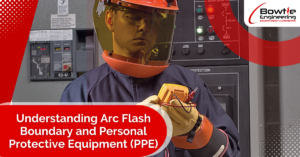BENEFITS OF READING THIS BLOG
- Enhance Workplace Safety: Learn how to create a safer work environment by understanding and mitigating arc flash hazards.
- Prevent Arc Flash Incidents: Gain knowledge on how to prevent potentially catastrophic electrical incidents in your workplace.
- Comprehend Arc Flash Boundary Concepts: Understand the critical concept of arc flash boundaries and their significance in safety.
- Gain Insight into PPE Selection: Discover how to select the right Personal Protective Equipment (PPE) for effective arc flash protection.
- Compliance with Safety Regulations: Ensure your workplace complies with safety regulations and standards, avoiding legal and safety risks.
- Protect Personnel from Electrical Hazards: Learn how to safeguard your employees from electrical hazards, reducing injury risks.
- Reduce Workplace Injuries: Implement best practices to minimize workplace injuries and improve overall safety.
- Improve Electrical Systems Management: Enhance your ability to manage electrical systems, reducing the likelihood of arc flash incidents.
Introduction
In today’s industrial landscape, electrical hazards are a real and present danger. One of the most devastating incidents that can occur in an electrical environment is an arc flash. Understanding arc flash boundaries and the importance of Personal Protective Equipment (PPE) is critical for ensuring the safety of personnel working with or near electrical equipment. In this comprehensive guide, we will delve into the intricacies of arc flash, what an arc flash boundary is, how to select the right PPE, and why it’s essential to comply with safety regulations. By reading this article, you will gain insights into enhancing workplace safety, preventing arc flash incidents, and ultimately protecting the lives of those who work with electricity.

What is Arc Flash?
An arc flash is a sudden, explosive release of electrical energy that occurs when there is an electrical fault or short circuit in an electrical system. This phenomenon is characterized by an intense, blinding flash of light and an extremely high-temperature plasma discharge. The consequences of an arc flash incident are severe and can include severe burns, blast pressure, shrapnel, and even death.
Statistically, arc flash incidents are more common than you might think. They occur daily in workplaces around the world, resulting in injuries and fatalities. The key to preventing arc flash incidents lies in understanding the concept of the arc flash boundary and the appropriate use of Personal Protective Equipment.
Arc Flash Boundary Defined
The arc flash boundary is a crucial safety concept that defines the distance from a potential arc flash source within which a person could be exposed to a second-degree burn if an arc flash were to occur. It is determined based on various factors, including the available fault current, the duration of the fault, and the arc’s energy level. The arc flash boundary is typically expressed in feet or meters and is marked with appropriate signage in the workplace.
Understanding the arc flash boundary is essential for several reasons. Firstly, it helps workers identify the potential danger zones, allowing them to stay outside the boundary whenever possible. Secondly, it aids in the proper selection of Personal Protective Equipment, as the level of protection required depends on the arc flash energy within this boundary.
Personal Protective Equipment (PPE)
PPE plays a pivotal role in safeguarding workers from the devastating effects of an arc flash. There are various types of PPE designed specifically for arc flash protection, including flame-resistant clothing, face shields, helmets, gloves, and arc-rated footwear. Selecting the right PPE is not a one-size-fits-all process; it depends on the specific hazards present and the energy level within the arc flash boundary.
Choosing appropriate PPE involves considering factors such as the incident energy, the required Arc Thermal Performance Value (ATPV) or Energy Breakopen Threshold (EBT), and the Hazard Risk Category (HRC) of the task. An incorrect selection of PPE can lead to inadequate protection, putting workers at risk.
Safety Regulations and Compliance
Safety regulations and compliance standards are in place to ensure that organizations prioritize the safety of their employees when working with electrical equipment. Regulatory bodies like OSHA (Occupational Safety and Health Administration) and NFPA (National Fire Protection Association) have established guidelines and standards that must be followed to prevent arc flash incidents.
Compliance with safety regulations is not merely a matter of legal obligation; it is a moral and ethical responsibility. Non-compliance can result in severe consequences, including fines, legal action, and most importantly, the endangerment of lives. By adhering to these standards, organizations demonstrate their commitment to protecting their workforce.
Protecting Personnel
Protecting personnel from electrical hazards involves a multi-faceted approach. Beyond selecting the right PPE and complying with regulations, it also requires a strong emphasis on training and awareness. Employees should be well-informed about the potential risks of arc flash and the necessary precautions to take.
Training programs should cover topics like recognizing potential arc flash hazards, understanding the arc flash boundary, and properly using PPE. Additionally, personnel should be trained in emergency response procedures in case an arc flash incident does occur.
Real-life case studies serve as powerful reminders of the importance of protecting personnel. Learning from past incidents and understanding the human and financial costs of arc flash accidents can motivate organizations to invest in safety measures.
Reducing Workplace Injuries
One of the most compelling benefits of prioritizing arc flash safety is the significant reduction in workplace injuries. Electrical injuries can be life-altering, causing severe burns, permanent disabilities, and even fatalities. By implementing proper safety measures, organizations can mitigate these risks and create a safer work environment.
Reducing workplace injuries not only benefits employees but also has positive effects on the organization. Fewer injuries mean reduced medical costs, lower workers’ compensation claims, and increased productivity due to a healthier and safer workforce. Moreover, it contributes to the overall well-being and morale of employees, leading to a more positive workplace culture.
Managing Electrical Systems
Preventing arc flash incidents isn’t just about reacting to potential hazards; it’s also about proactive measures to manage electrical systems effectively. Regular maintenance practices are crucial for identifying and rectifying issues that could lead to arc flash incidents.
Routine inspections of electrical equipment can identify signs of wear and tear, loose connections, or other issues that may increase the risk of an arc flash. By addressing these issues promptly, organizations can prevent potential incidents.
Conclusion
In conclusion, understanding arc flash boundaries and the importance of Personal Protective Equipment (PPE) is paramount for workplace safety. By reading this article, you’ve gained insights into the benefits of enhancing workplace safety, preventing arc flash incidents, and ultimately protecting the lives of those who work with electricity.
Additionally, upgrading electrical systems with advanced protective devices, such as arc flash relays and circuit breakers with arc fault protection, can significantly reduce the likelihood of arc flashes. Investing in modern technology can be a proactive step toward a safer workplace.
 Skip to content
Skip to content 